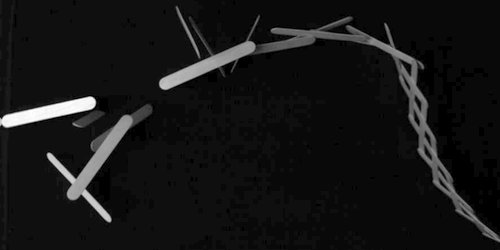August 29, 2017 report
High-speed video study reveals the nature of the cobra wave

A small team of researchers from multiple institutions in France has learned more about the properties of the "cobra wave" by building structures from popsicle sticks and filming wave progressions with a high-speed camera. In their paper published in the journal Physical Review Letters, Jean-Philippe Boucher, Christophe Clanet, David Quéré and Frédéric Chevy describe the series of experiments they carried out with the sticks and what they learned in the process.
A cobra wave is, by definition, a wave that occurs when popsicle sticks are bound together in a certain way under tension and are then released—the sticks become unbound as the wave propagates the length of the structure. Understanding the cobra wave and how it works is important because researchers believe that some biological processes work in the same way.
To learn more about the cobra wave, the group assembled a large number of popsicle lattices in arrangements that were similar to previous methods of creating the effect—each resembled a number of Xs lined up next to one another, sort of like the small fences used in a flower garden. The two ends had a different configuration, with sticks placed in such a way as to prevent adjacent ones from unraveling. Once the structure is set, all it takes is pulling one stick from the end to create the wave, which moves in fashion similar to dominoes—one stick unraveling causes the next to unravel, until the structure is undone. There is one particularly unique characteristic of the wave—as it gets going, the part of the structure that has not come undone rises into the air, causing the structure to bend in the shape of a cobra about to strike. Another characteristic of the structure and associated wave is the sticks flying every which way as the wave progresses, creating an impressive display.
Via highs-speed video of multiple waves in action with the variably sized popsicles sticks arranged in slightly different ways, the researchers learned that stick length must fit into a narrow range of possibilities. They also found that the recoil was due to sticks being ejected. The sticks, of course, got their kinetic energy from the stored potential energy derived from bending. The team also derived wave speed formulas based on characteristics of the sticks. As for the unique cobra shape, the team found that it resulted from competition between the recoil from sticks being ejected and gravitational forces.
More information: Jean-Philippe Boucher et al. Popsicle-Stick Cobra Wave, Physical Review Letters (2017). DOI: 10.1103/PhysRevLett.119.084301
Journal information: Physical Review Letters
© 2017 Phys.org


















